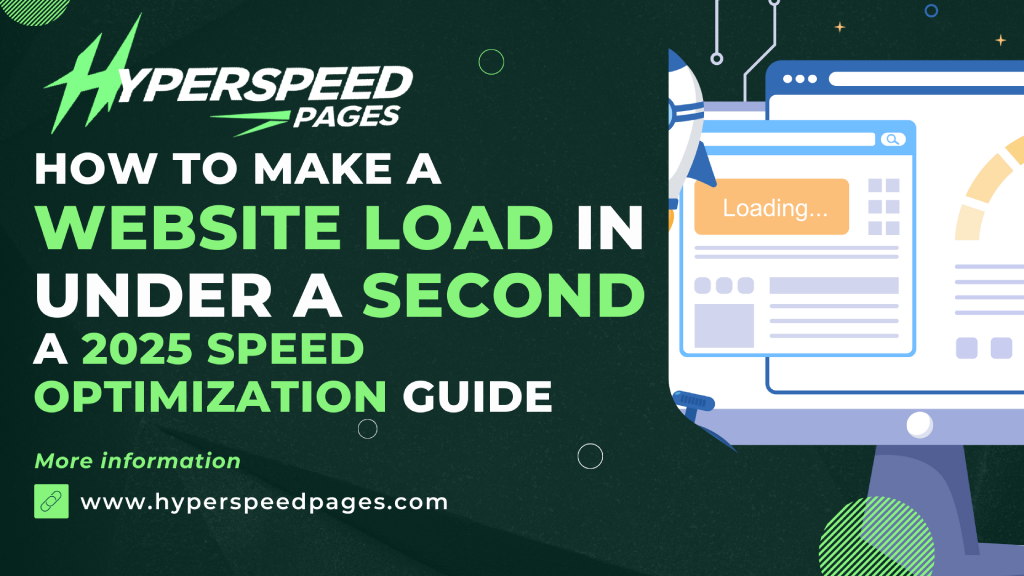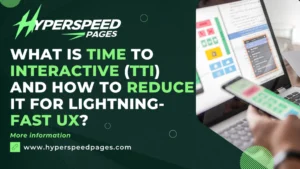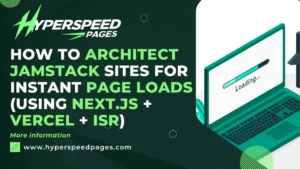
TL;DR – Quick Summary
Website speed is a ranking factor, a conversion driver and a retention imperative instead of mere luxury. Here, we’ll break down the technical, strategic, and architectural decisions needed to consistently load websites in under one second, covering both frontend and backend techniques, modern tools, and AI-driven optimization frameworks.
Why Website Speed Matters More Than Ever in 2025
- “Why is my website slow even on a 5G connection?”
- “How do I make my page load instantly?”
These are top questions across Ask Engines and voice search queries in 2025.
Key Reasons
- Google’s Core Web Vitals are stricter than ever, especially LCP (<1.2s)
- Instant-loading sites boost SEO rankings and user engagement
- Higher conversions: Amazon reports 1% revenue loss per 100ms delay
- Voice and wearable devices require ultra-low latency rendering
2025 Standard: First Contentful Paint (FCP) under 0.8s, Time to Interactive (TTI) under 1.5s
How Do You Make a Website Load in Under 1 Second?
Let’s break it down across 7 critical layers:
Server Response Time: Aim for TTFB < 100ms
Actions:
- Use edge networks (CDNs) like Cloudflare Workers, Akamai EdgeWorkers, or Netlify Edge Functions.
- Cache everything: Use HTTP caching headers and full-page edge caching.
- Use serverless or JAMstack: Pre-render pages and serve from the edge.
Tools
- Cloudflare / Fastly CDN
- Upstash Redis for edge caching
- Pingdom or WebPageTest to audit TTFB
AEO Tip: Pages with low TTFB are more likely to be included in voice search and featured snippets.
Frontend Optimization: Minimal, Modular, and Lazy-Loaded
Reduce JS + CSS
- Use ESM (ECMAScript Modules) with tree shaking
- Replace jQuery with Vanilla JS
- Split large bundles using dynamic import() in Webpack or Vite
Lazy Load
- Images ()
- Videos (only on scroll)
- Third-party scripts (analytics, chatbots)
Eliminate render-blocking
- Inline critical CSS for above-the-fold content
- Use async/defer for JS
Frameworks like Next.js 14, Astro, or Qwik provide ultra-fast hydration and island architecture.
Image Optimization: Modern Formats + CDNs
Switch to:
- AVIF or WebP (80% smaller than JPEG)
- Responsive
for varying screen sizes
Use CDNs with smart compression
ImageKit, Cloudinary, Imgix
Bonus
- Add fetchpriority=”high” to critical LCP images
- Preload hero image via <link rel=”preload”>
Tip: Always compress images to <100KB, especially for mobile-first audiences.
Preloading, Pre-connecting, and Prefetching
These are crucial for building perceived speed and helping the browser prepare assets in advance.
Use Cases
- Preload fonts and key UI images
- Preconnect to third-party services (e.g., Stripe, analytics)
Web Hosting Stack & Deployment Strategy
Cloud hosting in 2025 demands:
- Edge rendering using Vercel, Netlify, or Cloudflare Pages
- SSR + SSG hybrid approach for dynamic pages
- CI/CD pipelines with automated Lighthouse scoring
Deployment Checklist
- Global CDN distribution
- Static asset versioning
- Atomic deployments (zero downtime)
Vercel’s Edge Middleware and ISR (Incremental Static Regeneration) help serve personalized content fast without bloating the main build.
Fonts and Third-Party Scripts: Your Biggest Bottlenecks
Fonts
- Use system fonts or host your own WOFF2
- Set font-display: swap to eliminate FOIT (Flash of Invisible Text)
Third-party JS
- Load using async or delay with user interaction
- Use Partytown (by Builder.io) to run third-party scripts in a Web Worker
Tip: Use Google Tag Manager judiciously. Offload marketing scripts where possible to keep the main thread clean.
Performance Budgets & Continuous Monitoring
– Define KPIs
| Metric | Target |
| TTFB | < 100ms |
| LCP | < 1.2s |
| FID | < 100ms |
| TTI | < 1.5s |
| CLS | < 0.1 |
| Total JS | < 150KB |
| Total Page Weight | < 1MB |
– Monitoring Tools
- Lighthouse CI + Github Actions
- Calibre, SpeedCurve, Pingdom
- RUM (Real User Monitoring) via LogRocket or Datadog
Set performance budgets in CI to fail builds if metrics are exceeded.
AEO Optimization: Make Your Speed Discoverable
Speed alone doesn’t answer user queries. For Ask Engine Optimization, you must:
- Add FAQ sections with natural language queries:
“How do I make my website load instantly on mobile?”
“What affects my site’s Core Web Vitals score?”
- Use Speakable schema for featured snippet eligibility
- Provide code samples and tool links to build trust and depth
Bonus: AI Tools That Help You Speed Up in 2025
| Task | Tool |
| Real-time code analysis | CodeWhisperer, Cursor AI |
| Automatic LCP detection | SpeedVitals, Treo Sites |
| Image compression automation | Imagify, Squoosh AI |
| Autocomplete best practices | ChatGPT Dev Assistants, GitHub Copilot |
FAQs
1. What is a good website load time in 2025?
Anything under 1 second for desktop and under 1.5 seconds for mobile.
2. How can I test my site’s speed?
Use Lighthouse, PageSpeed Insights, or WebPageTest.org for both lab and real-world data.
3. Do Core Web Vitals impact SEO rankings?
Yes. Google confirmed that Core Web Vitals are part of the page experience signals used in ranking.
4. What’s the best stack for fast-loading sites?
Jamstack with Next.js or Astro, deployed via Vercel or Netlify, with assets served via CDN.
5. Can I make an eCommerce site load in under a second?
Yes, with static generation, CDN caching, and optimized media, many stores achieve sub-second loads.
Speed Is a Strategy
Speed is not just a technical requirement, it’s a competitive advantage. When users expect instant gratification, and search engines prioritize fast-loading pages, a website that loads in under one second is a business asset.




